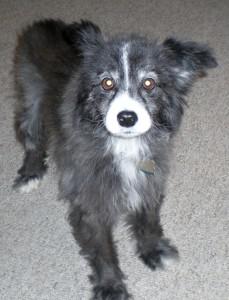
Annie at age 14
The first time I saw Annie, she was hiding in our garage in St. Louis under our minivan of the moment, a Mercury Villager. My son, Paul, had fallen in love with her at the Humane Society of Missouri, and he and my wife, Pat, brought her home. I had no say in the matter, but that was OK; our other dog, Mork, grudgingly accepted Annie, and if he was OK with her, then I was too. That was the spring of 1997, and she was about 1½ years old.
We were told that Annie had been abused, and we could tell. She was wary of people, and she easily fell into her cowering pose. Over time, she loosened up a bit, but it took years, and even then, she could revert to skittishness. She gradually got used to us.
She really came into her own when we moved to Arizona in 2003. By then, Mork had been put to sleep. Paul had moved out of the house and had taken Annie with him, but he thought she’d have a better life with us in Phoenix and bequeathed her to us.
I had moved to Arizona ahead of the rest of the family to take the top PR position at Phelps Dodge Corp. A few weeks later, Pat and our daughter, Kate, drove west from St. Louis to bring Kate back to college in California. They brought Annie with them and stopped in Phoenix to drop her off. Annie and I became roommates for a few months.
I had a studio apartment while we were searching for a home, furnished simply with a rented couch, bed and some miscellaneous items. Annie slept on the couch for a few nights. Then one night, she got up, looked around, and decided to climb onto the foot of the bed. She was my closest friend in Phoenix for a few months; it was our bonding time.
Once we all moved into our house in Phoenix, Annie had a fenced yard, and she owned it. She waited for birds to jump from the top of the fence into the yard, ready to rush them and reclaim all the ground as hers.
I walked her each day for years, and she couldn’t wait for me to get out the leash and get the door opened. Invariably , I’d get one of two questions from people we encounter: “What kind of dog is that?” and “Is she a puppy?” The second question kept coming even as little as six months ago, although she was nearly 16. She had a spring in her step and a sparkle in her eye, and she stayed thin, so people thought she was young until I pointed out the gray that had crept into her coat.
To the first question, the best comment I ever heard from someone I encountered on our walks was: “If she isn’t a breed, she should be!”
The honest answer was that she was just a mutt. We thought she looked like a border collie in the face, but at 17 pounds, she wasn’t big enough to be a true border collie. She had a herding instinct. When we took her to the dog park, she had no trouble standing up to dogs three times her size, and she often was able to move them along like sheep.
In the past few months, Annie faded quickly. She paced throughout the house almost nonstop all night long. She would stand and stare into space, looking lost. Her vision and hearing failed, and she would end up wedged into tight spaces between pieces of furniture, unable to figure out how to free herself again. She turned up her nose at most food, and she couldn’t keep down what she did eat.
Two nights ago, about 4 in the morning, I got up and held her for about an hour. She got some sleep, but when she woke up, she got down and started her nonstop pacing again. She seemed unable to find any peace, and there was nothing to indicate that she was finding any pleasure in life or that she would find it again.
So yesterday, after consulting with her veterinarian, we put Annie to sleep. I’ve had to go through this before, and each time seems harder than the last.
The last time I saw Annie, she was succumbing to the sedative in the doctor’s office. She seemed to be at peace. I told her I’d see her again on the other side. I think she gave me a little nod.

